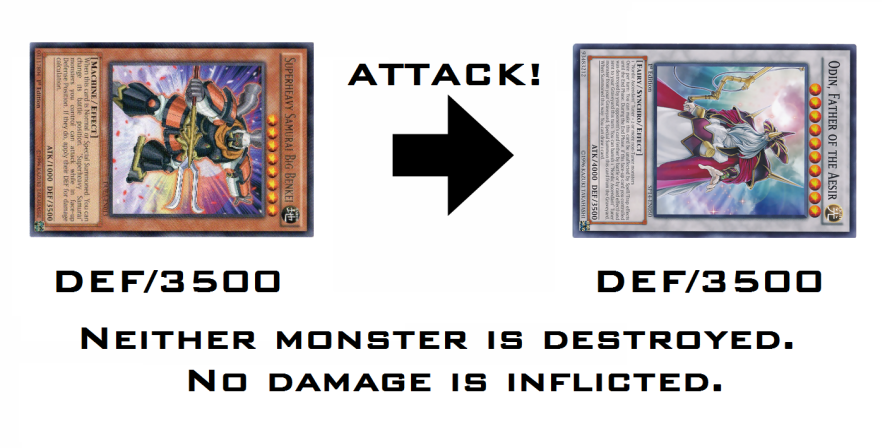Duelist Alliance officially goes on sale today! This means that a ton of new and surprisingly good cards are now available for tournament play, such as Chain Dispel, and Yuya Sakaki’s Ace monster Odd-Eyes Pendulum Dragon. But this post will actually be about different card, one that is sure to cause some confusion. Say hello to Noboru Gongenzaka’s Ace monster, Superheavy Samurai Big Benkei!
When this card is Normal or Special Summoned: You can change its battle position. “Superheavy Samurai” monsters you control can attack while in face-up Defense Position. If they do, apply their DEF for damage calculation.
Older players will immediately be reminded of two older cards: Total Defense Shogun, and Elemental HERO Rampart Blaster. Both of these cards also have the unique ability to attack while in Defense Position, but there is a key difference between these cards and Big Benkei up there. The difference is that these cards still use their ATK when attacking in Defense Position, but Big Benkei (and all other Superheavy Samurai in his presence) uses his DEF.
This is where I got hung up, and I don’t doubt a lot of other players experienced the same confusion as me. What happens if Superheavy Samurai Big Benkei attacks a monster with less ATK or DEF than his own DEF while he’s in Defense Position? There are two possible answers to this question.
The first possible answer is Big Benkei deals battle damage if the attack target is in Attack Position, but does not destroy it by battle.
The second answer is that Big Benkei will inflict battle damage if the attack target is in Attack Position, but WILL destroy the monster by battle either way.
Only one of these is correct and some of you will be surprised to learn that it’s NOT the first one. Yep, you read that right. Big Benkei and his Superheavy allies can and will destroy stuff by battle while attacking in Defense Position, even though they are applying their DEF. So why is that?
It’s because they’re attacking. The rules of the game says that a monster can only attack while in Attack Position, and that you apply that monster’s ATK for damage calculation. Big Benkei bypasses both of these rules, but the one fundamental factor of battle remains unchanged: One monster is attacking, and attacking monsters can destroy other monsters by battle.
It can’t be that simple, can it? It can. The rulebook uses the following phrases when detailing the rules for battling.
Each face-up Attack Position monster you control is allowed 1 attack per turn. (Version 8.0, Pg.32)
You calculate Battle Damage based on the battle position of the monster you are attacking. If you attack an Attack Position monster, compare ATK vs. ATK. If you attack a Defense Position monster, compare your monster’s ATK vs. the attacked monster’s DEF. (Version 8.0, Pg.35, emphasis added)
In addition to that, the first two sections for calculating damage on pages 35 and 36 (Version 8.0) are labeled as follows.
When You Attack an Attack Position Monster (Version 8.0, Pg.35)
When You Attack a Defense Position Monster (Version 8.0, Pg.36)
Finally, the section on direct attacks is as follows.
If there are no monsters on your opponent’s side of the field, you can attack directly. The full amount of your attacking monster’s ATK is subtracted from the opponent’s Life Points as Battle Damage. (Version 8.0, Pg. 36)
What Superheavy Samurai Big Benkei does is essentially rewrite those sections so that you are applying your monster’s DEF instead of ATK. Nothing else is changed, so everything else about those rules is still applied. This is a handy way to remember this rule: Just substitute “your attacking monster’s ATK” in the rulebook with “your attacking monster’s DEF”. Suddenly, his effect is so much easier to understand.
But for those who still don’t quite get it, let me just illustrate it for you. Let’s say you control Big Benkei in Defense Position, while your opponent controls Odd-Eyes Pendulum Dragon (2500 ATK). If you attack Odd-Eyes with Big Benkei, Odd-Eyes will be destroyed by battle, and your opponent will take 1000 battle damage.
Now let’s say Odd-Eyes has a boost from Blustering Winds. This puts its ATK at 3500, exactly equal to Big Benkei’s DEF. If a Defense Position Superheavy Samurai Big Benkei were to attack Odd-Eyes in this situation, both monsters would be destroyed by battle.
Well that covers attacking monsters in Attack Position. But what about monsters in Defense Position? How does that work? Pretty much the same way. If Big Benkei attacks a Defense Position monster with lower DEF than his own, while Benkei himself is in Defense Position, that monster is destroyed, but no battle damage is inflicted.
And what if he attacks a monster with the same DEF? Surely both monsters would be destroyed, right? Nope. If he attacks a monster with equal DEF to his own, Big Benkei will be unable to destroy it. In fact, neither monster is destroyed, and no damage is inflicted.
By now, you should have an idea of how this works, but just in case, I will cover one last scenario: If Big Benkei attacks a Defense Position monster whose DEF is higher than his own, neither monster is destroyed, but Big Benkei’s controller will take damage equal to the difference in DEF.
So to summarize once more, when attacking with Defense Position “Superheavy Samurai” monsters while Superheavy Samurai Big Benkei is on the field, just follow the charts on pages 35 and 36 of the rulebook (Version 8.0 as of this writing), using your Superheavy Samurai’s DEF in place of its ATK.
The Superheavy Samurai will be receiving more support in The New Challengers, slated for TCG release on November 7, 2014, so hang in there guys! In the meantime, I’ll keep looking for stuff to write about. I’ve already got a particularly interesting idea I’ll be working on, but I’ll keep the details to myself for now. But if you have any suggestions, then let me know in the comments or by emailing me.
Until next time, keep dueling!




